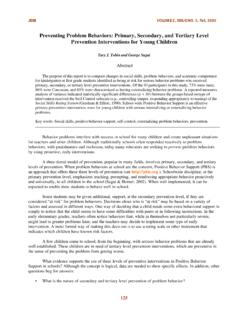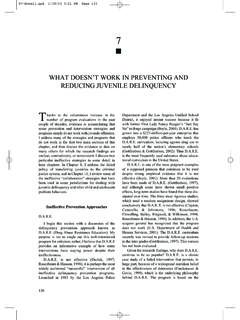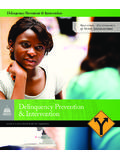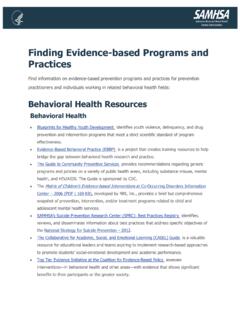Transcription of Prevention and Intervention Programs for Juvenile …
1 Prevention and Intervention Programs for Juvenile OffendersVOL. 18 / NO. 2 / FALL 2008 185 Prevention and Inter vention Programs for Juvenile OffendersPeter GreenwoodSummaryOver the past decade researchers have identified Intervention strategies and program models that reduce delinquency and promote pro-social development. Preventing delinquency , says Peter Greenwood, not only saves young lives from being wasted, but also prevents the onset of adult criminal careers and thus reduces the burden of crime on its victims and on society. It costs states billions of dollars a year to arrest, prosecute, incarcerate, and treat Juvenile offend-ers.
2 Investing in successful delinquency - Prevention Programs can save taxpayers seven to ten dollars for every dollar invested, primarily in the form of reduced spending on to Greenwood, researchers have identified a dozen proven delinquency - Prevention Programs . Another twenty to thirty promising Programs are still being tested. In his article, Greenwood reviews the methods used to identify the best Programs , explains how program success is measured, provides an overview of Programs that work, and offers guidance on how jurisdictions can shift toward more evidence-based practicesThe most successful Programs are those that prevent youth from engaging in delinquent behaviors in the first place.
3 Greenwood specifically cites home-visiting Programs that target pregnant teens and their at-risk infants and preschool education for at-risk children that includes home visits or work with parents. Successful school-based Programs can prevent drug use, delinquency , anti-social behavior, and early school also discusses community-based Programs that can divert first-time offenders from further encounters with the justice system. The most successful community Programs empha-size family interactions and provide skills to the adults who supervise and train the in implementing effective Programs , says Greenwood, is slow.
4 Although more than ten years of solid evidence is now available on evidence-based Programs , only about 5 percent of youth who should be eligible participate in these Programs . A few states such as Florida, Penn-sylvania, and Washington have begun implementing evidence-based Programs . The challenge is to push these reforms into the mainstream of Juvenile Greenwood is the executive director of the Association for the Advancement of Evidence-Based Greenwood186 THE FUTURE OF CHILDREN There are many reasons to pre-vent juveniles from becoming delinquents or from continuing to engage in delinquent behav-ior.
5 The most obvious reason is that delinquency puts a youth at risk for drug use and dependency, school drop-out, incar-ceration, injury, early pregnancy, and adult criminality. Saving youth from delinquency saves them from wasted But there are other reasons as adult criminals begin their criminal careers as juveniles. Preventing delinquency prevents the onset of adult criminal careers and thus reduces the burden of crime on its victims and on society. Delinquents and adult offenders take a heavy toll, both financially and emotionally, on victims and on taxpayers, who must share the costs.
6 And the cost of arresting, prosecuting, incarcerating, and treating offenders, the fastest growing part of most state budgets over the past decade, now runs into the billions of dollars a year. Yet recent analyses have shown that investments in appropriate delinquency - Prevention Programs can save taxpayers seven to ten dollars for every dollar invested, primarily in the form of reduced spending on The prospect of reaping such savings by pre-venting delinquency is a new one. During the early 1990s, when crime rates had soared to historic levels, it was unclear how to go about preventing or stopping delinquency .
7 Many of the most popular delinquency - Prevention Programs of that time, such as DARE, Scared Straight, Boot Camps, or transferring juveniles to adult courts, were ineffective at best. Some even increased the risks of future during the past fifteen years have re-searchers begun clearly identifying both the risk factors that produce delinquency and the interventions that consistently reduce the likelihood that it will occur. Some of the identified risk factors for delinquency are genetic or biological and cannot easily be changed. Others are dynamic, involving the quality of parenting, school involvement, peer group associations, or skill deficits, and are more readily altered.
8 Ongoing analyses that carefully monitor the social development of cohorts of at-risk youth beginning in infancy and early childhood continue to refine how these risk factors develop and interact over time. 4 Fairly strong evidence now demonstrates the effectiveness of a dozen or so proven delinquency - Prevention program models and generalized Somewhat weaker evidence supports the effectiveness of another twenty to thirty promising Programs that are still being tested. Public agencies and private providers who have implemented proven Programs for more than five years can now share their experiences, some of which have been closely monitored by independent For the first time, it is now possible to follow evidence-based practices to prevent and treat this article, I discuss the nature of evidence-based practice, its benefits, and the challenges it may pose for those who adopt it.
9 I begin by reviewing the methods now being used to identify the best Programs and the standards they must meet. I follow with a comprehen-sive overview of Programs that work, with some information about Programs that are proven failures. I conclude by providing guidance on how jurisdictions can implement best practices and overcome potential barriers to successful implementation of evidence-based and Intervention Programs for Juvenile OffendersVOL. 18 / NO. 2 / FALL 2008 187 Determining What WorksMeasuring the effects of delinquency - Prevention Programs is challenging because the behavior the Programs attempt to change is often covert and the full benefits extend over long periods of time.
10 In this section, I review the difficulties of evaluating these Programs and describe the evaluation standards that are now generally accepted within this field. Evaluation Methods and ChallengesFor more than a century, efforts to prevent delinquency have been guided more by the prevailing theories about the causes of delin- quent behavior than by whether the efforts achieved the desired effects. At various times over the years, the primary causes of delin-quency were thought to be the Juvenile s home, or neighborhood, or lack of socializing experiences, or lack of job opportunities, or the labeling effects of the Juvenile justice The preventive strategies promoted by these theories included: removal of urban children to more rural settings, residential training schools, industrial schools, summer camps, job Programs , and diversion from the Juvenile justice system.

















